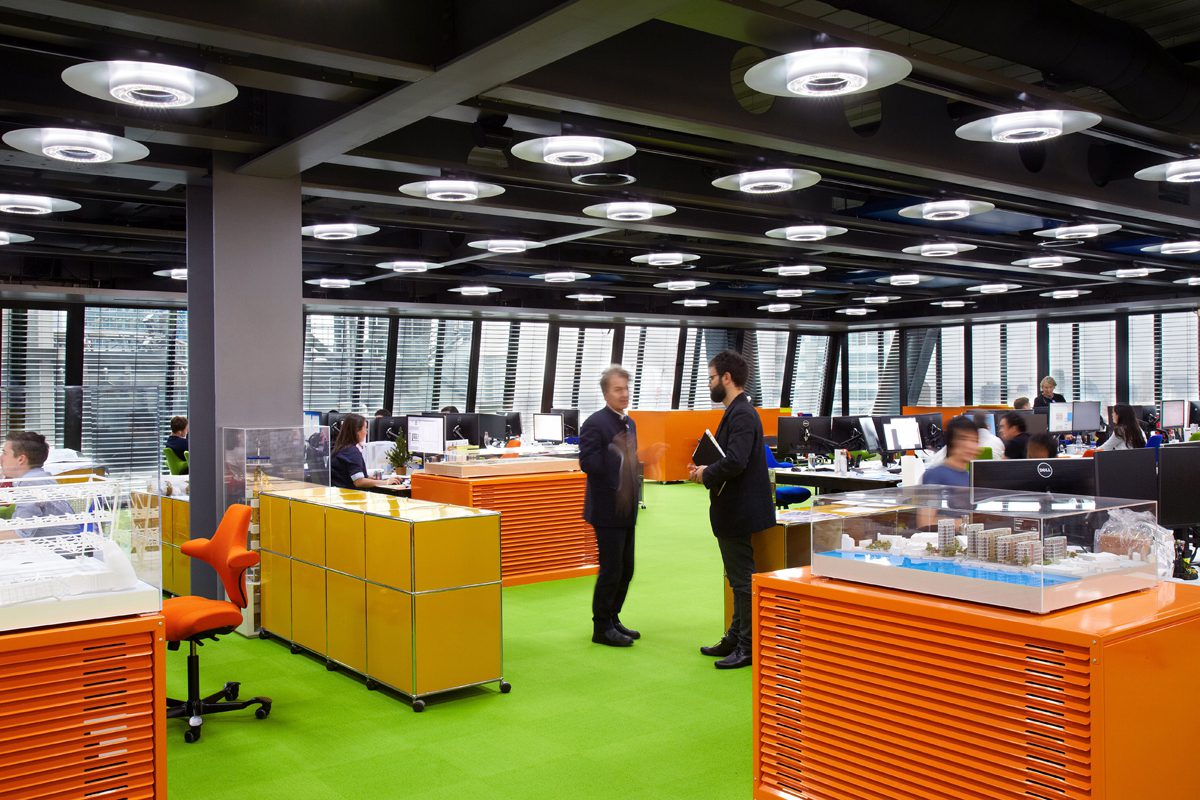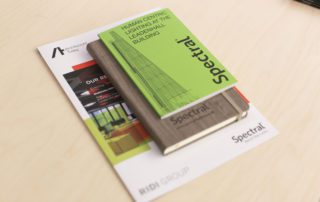How can lighting design enhance wellness and productivity? This was the question addressed at a seminar hosted by Architecture Today and Spectral at Arup’s London headquarters. Ruth Slavid reports.
In association with![]()
Seminar Participants
Florence Lam
Arup Fellow and Global Lighting Design Leader, Arup
Stuart Peirson
Associate Professor, Nuffield Laboratory of Ophthalmology, and Group Leader, Sleep and Circadian Neuroscience Institution (SCNi)
Trevor Keeling
Associate, Sustainability and Building Physics, Buro Happold
Jon Estell
Head of Spectral UK
Chris Foges
Editor, Architecture Today
There can be few fields where science and design expertise have advanced together so quickly as in the area of lighting. Neurologists have learnt a great deal about how light affects our brains and sets a range of body clocks. LED technology has become increasingly sophisticated so that it is now possible to produce and control subtleties of colour in lighting in an affordable way. Lighting designers and manufacturers are embracing these possibilities to produce projects that should enhance wellness and happiness, while continuing with their own research to enhance knowledge even further. These were some of the outcomes from an event entitled ‘Our Relationship with Light’ that AT and Spectral organised at the Arup headquarters in London.
Florence Lam
Lighting and the body
Florence Lam, who leads Arup’s lighting design practice and gave the first speech of the evening, was wearing what looked like a chunky fitness tracker, as were several of her colleagues. These trackers include light sensors and measure temperature, movement and sleep. The team fill out regular questionnaires and undertake games to test their visual attention. The aim is to better understand how exposure to light affects the behaviour of the human body.
In her talk, having touched on some of the advances in knowledge, Lam said, “I’m a lighting designer not a chronobiologist”. The scientific explanations came from Stuart Peirson who rejoices in the title of associate professor, Nuffield Laboratory of Ophthalmology, and group leader, Sleep and Circadian Neuroscience Institution. In other words, he is working at the forefront of what we know.
He took delegates on a fascinating lightning tour through what is understood today about our circadian rhythms that regulate numerous ‘clocks’ within the body. Crucially the clocks are kept to time by non-visual photoreceptors called pRGCs. These contain the pigment melanopsin, which sends signals to set the clocks. Otherwise we would drift off our 24-hour settings. These non-visual receptors have their maximum sensitivity at a wavelength of 480nm, which is in the blue-green range. It is quite a shift from our maximum sensitivity to light for vision, which is about 555nm, where sensitivity to both red and green is maximised. This means, explained Peirson, that “lighting optimised for vision will not account for its other biological effects”.
There is still a lot to learn, Peirson explained. Our belief that blue light in the evening causes sleep problems is, he said, simplistic. And we need to understand how our changes in behaviour relating to having light in the evening and less intensity of light during the day than our ancestors, have shifted our biological clocks.
Stuart Peirson
Designing in wellness
Results of this pure research feed into practice and into our desire to design in wellness. This is quantified in the American WELL Building Standard, which certifies buildings that score well in seven categories. One of these is light. Trevor Keeling, an associate at Buro Happold Engineering, explained that in the lighting category, building users should “benefit from daylight and lighting systems designed to increase alertness, enhance experience and promote sleep”.
He went on to detail a lot of the requirements. While many make sense and are best practice, such as enhancing access to daylight and visual comfort, he warned that this approach can be formulaic and leaves out a lot. “It misses out a lot of the elements of visual experience”, he said.
Trevor Keeling
The importance of daylight
Enhancing the visual experience is what Florence Lam’s team is concerned with. She appreciates the importance of access to daylight, but accepts that this is not always possible in increasingly crowded cities with large buildings. Indeed, when she questioned the audience, very few people said that they worked in daylit offices.
For Lam then it is important to bring, as far as possible, the benefits of daylight to places where the real thing is not physically available. She discussed a project for Benjamin West Studio in which the practice made it seem as if daylight was coming into a basement. It did this by using an artificial skylight in a glass-walled private office, which appeared to have ever-changing real daylight coming through it, in a way that was convincing both to people in that space and in the main office. In that main office, changing colour temperatures during the day simulate the way that natural light changes.
Designed by Speirs & Major in association with Spectral, the lighting at Rogers Stirk Harbour & Partners’ office in the Leadenhall Building, London, changes throughout the day, and is intended to provide both physical and psychological comfort (ph: Spectral)
Human-centric office lighting
Arup carried out surveys that showed that people were happy in the office, with better moods. Similar results are appearing at the new office of architect Rogers Stirk Harbour & Partners, which is located within its Leadenhall Building in the City of London. Jon Estell, head of Spectral UK, which supplied the lighting, explained that the challenge was to apply the principles of human-centric lighting to this very prestigious architect’s office.
RSHP employed Speirs & Major and Spectral to give it a solution where, said the practice’s Maurice Brennan, “the aim was to add a level of physical and psychological comfort to a space where the team often works long hours”. The architect wanted to explore the use of white light where the colour could be tuned during the day. It also wanted an office without dropped ceilings and where the needs of different working areas could be satisfied. For instance, general studio space was treated differently depending on whether it was near a window or more distant. The model-making workshop, circulation spaces and cafe also all had differing requirements.
ph: Spectral
The lights supplied satisfied the requirements that they should minimise glare and flicker. The lighting cycles from a gentle start in the morning of 450 lux in warm white, to a more intense 800 lux cold white by mid-morning. At lunchtime it dials down again to 450 lux warm white before ramping up again in the afternoon to the mid-morning condition, and then back down to 450 lux and warm white in the late afternoon. That’s the basic pattern, but everything is fully adjustable. Estell said that feedback, after a learning curve, has been positive.
Lighting design and specification requires an ever-growing amount of knowledge, but there are certainly rewards, as delegates learned at this fascinating event.
Contact Details
For more information please contact Spectral by calling 01279 450882, email or visit the website





























